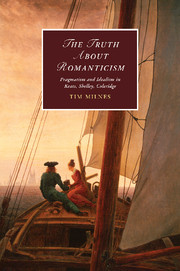Book contents
- Frontmatter
- Contents
- Acknowledgements
- Introduction: The pragmatics of romantic idealism
- 1 Romanticising pragmatism: dialogue and critical method
- 2 Pragmatising romanticism: radical empiricism from Reid to Rorty
- 3 This living Keats: truth, deixis, and correspondence
- 4 An unremitting interchange: Shelley, elenchus, and the education of error
- 5 The embodiment of reason: Coleridge on language, logic, and ethics
- Conclusion
- Notes
- Bibliography
- Index
- CAMBRIDGE STUDIES IN ROMANTICISM
3 - This living Keats: truth, deixis, and correspondence
Published online by Cambridge University Press: 06 July 2010
- Frontmatter
- Contents
- Acknowledgements
- Introduction: The pragmatics of romantic idealism
- 1 Romanticising pragmatism: dialogue and critical method
- 2 Pragmatising romanticism: radical empiricism from Reid to Rorty
- 3 This living Keats: truth, deixis, and correspondence
- 4 An unremitting interchange: Shelley, elenchus, and the education of error
- 5 The embodiment of reason: Coleridge on language, logic, and ethics
- Conclusion
- Notes
- Bibliography
- Index
- CAMBRIDGE STUDIES IN ROMANTICISM
Summary
Keats remains, for many readers, the epistolary poet par excellence. Few today would countenance Paul de Man's claim that the importance of Keats's letters is easily ‘exaggerated’; indeed, it is more common to find critics insisting on their centrality to interpreting his poems. In particular, the letter Keats writes from Hampstead in late December 1817 to his brothers George and Tom, contains what must be one of the most critically overdetermined passages of prose in English literature: the rumination on ‘Negative Capability, that is when man is capable of being in uncertainties, Mysteries, doubts, without any irritable reaching after fact & reason’. Like Keats's later denigration of the literal as antithetical to the ‘life of allegory’, this abdication from ‘fact and reason’ can be depicted as contesting a second, important sense of ‘correspondence’: that of agreement or accord. By questioning the literal foundation of meaning and the factual status of belief, Keats undermines an empirical topos whereby correspondence is held to be the key relation underpinning meaning and truth – respectively, between the referring sign and its referent, and between the idea and its object. Through the ‘correspondence’ of letters, then, Keats subverts the ‘correspondence’ of epistemological harmony.
This anti-epistemic turn in Keats's writing has been interpreted in a number of ways: as evidence of a nascent Neo-Platonism imbibed from Benjamin Bailey's bookshelves; as the revival of eighteenth-century theories of sympathetic imagination modelled on Shakespeare; and as evidence of a developing engagement with Hazlitt's theories of art, knowledge and power.
- Type
- Chapter
- Information
- The Truth about RomanticismPragmatism and Idealism in Keats, Shelley, Coleridge, pp. 66 - 104Publisher: Cambridge University PressPrint publication year: 2010

